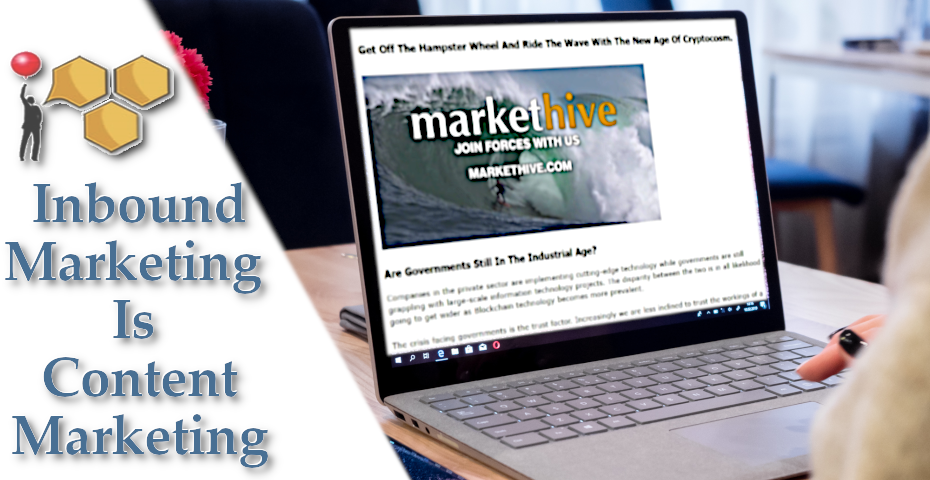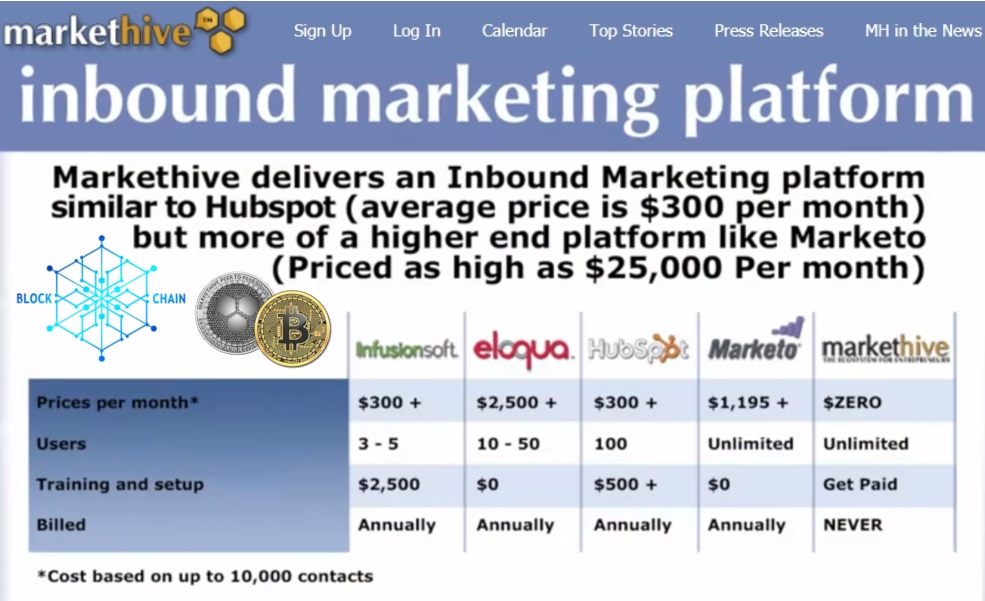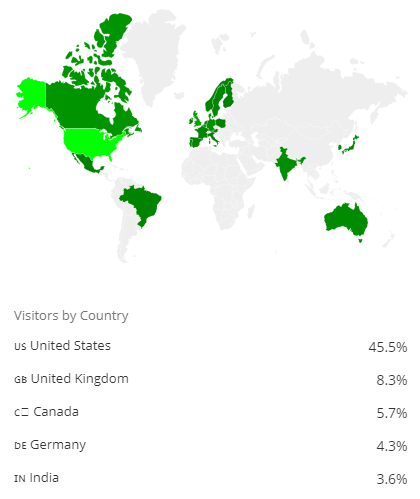
Inbound Marketing Is Content Marketing – Now On Blockchain At Markethive

Useful content should be at the core of your marketing. Content is the core of Inbound Marketing
Gone are the days where content means the blog posts your company writes. Instead, content marketing now includes a diverse set of content types and multiple channels to push them through. Chances are that if you’re already using social media, then you are doing content marketing to some extent.
Content marketing is accelerating at a blistering pace. By the year 2020, roughly 1.7 MB of new content will be created every second… for every living person on earth.
It’s easy to hear statistics like that and feel a sense of overwhelm – to feel like there’s no way to make your brand stand out from the crowd. But there is and I am going to show you how with this article.

What is content marketing?
To begin with, content marketing is taking any type of content (digital or physical) and purposefully sending it out to your audience.
Content marketing is a strategic marketing approach focused on creating and distributing valuable, relevant, and consistent content to attract and retain a clearly-defined audience — and, ultimately, to drive profitable customer action.
Instead of pitching your products or services, you are providing truly relevant and useful content to your prospects and customers to help them solve their issues.
Content marketing is used by leading brands. Research shows the vast majority of marketers are using content marketing. In fact, it is used by many prominent organizations in the world, including P&G, Microsoft, Cisco Systems, and John Deere. It’s also developed and executed by small businesses and one-person shops around the globe. Why? Because it works.
Content marketing aka “Inbound Marketing” is good for your bottom line — and your customers
Here are some key reasons and benefits for entrepreneurs and companies that use content marketing:
-
More awareness
-
Increased sales
-
Cost savings
-
Better, more loyal customers
-
Greater branding and online presence
Content is the present – and future – of inbound marketing
Go back and read the content marketing definition one more time, but this time remove the “relevant” and “valuable”. That’s the difference between content marketing and the other informational garbage you get from companies trying to sell you “stuff.”
Companies send us information all the time – it’s just that most of the time it’s not very relevant or valuable (can you say spam?). That’s what makes content marketing so intriguing in today’s environment of thousands of marketing messages per person per day.
Marketing is impossible without great content
Regardless of what type of marketing tactics you use, inbound marketing “content” should be part of your process, not something separate. Quality content is part of all forms of marketing:
-
Social media marketing: Content marketing strategy comes before your social media strategy.
-
SEO: Search engines reward businesses that publish quality, consistent content.
-
PR: Successful PR strategies address issues readers care about, not their business.
-
PPC: For PPC to work, you need great content behind it.
-
Inbound marketing: Content is key to driving inbound traffic and leads.
-
Content strategy: Content strategy is part of most content marketing strategies.
What if your customers look forward to receiving your marketing? What if when they received it, via print, email, website, they spent 15, 30, 45 minutes with it? What if they anticipated it and shared it with their peers?

Markethive Blogging Platform
Markethive Blogging platforms broadcast out to huge portfolios of social networks, news sites, forums, and WordPress blogs. Markethive blogs get easily indexed into the search engines, are subscribable by other Markethive members and subscription allows remote posting to their selection of social networks like Twitter, Facebook, and Linkedin. A content-rich blogging system with a reach into the millions across multiple social media and blogging platforms.
With Inbound Marketing, potential customers find you through channels like blogs, search engines, and social media which is exactly what you get and a whole lot more powerful tools, tutorials, mentoring, all integrated into a social network with selling platforms and exchanges.
Blockchain and Cryptocurrency Benefits
Additional benefits include receiving MHV Coin by your readers which adds more value to bloggers who have increased subscriber levels. You are paid by Markethive, the system, for writing and publishing your blogs instantly and continuously. All part of the micropayment faucet system within Markethive thanks to Blockchain Technology.
To be effective at inbound marketing (content marketing), it is essential to have an automated marketing system that embraces and enhances your marketing strategy.
The best part is that it is free with Markethive. The Markethive Inbound Marketing System can be compared with other platforms costing as much as $2,500 per month.

Join Markethive to learn what questions to ask and how to develop your strategy, where we deliver printed, video and live educational seminars to get you acclimated and up to speed.
Deb Williams
Market Manager for Markethive, a global Market Network, and Writer for the Crypto/Blockchain Industry. Also a strong advocate for technology, progress, and freedom of speech. I embrace "Change" with a passion and my purpose in life is to help people understand, accept and move forward with enthusiasm to achieve their goals.
FOLLOW US ON…
Website: https://markethive.com
Token Site: http://markethive.io/
Telegram: https://t.me/markethive_support
Twitter: https://twitter.com/markethive/
Github: https://github.com/markethive /
Reddit: https://www.reddit.com/r/markethive/
Crunchbase: https://www.crunchbase.com/organization/markethive
Medium: https://www.medium.com/@markethive
Bitcointalk: https://bitcointalk.org/index.php?topic=3309067.msg34535452#msg34535452
Telegram News: t.me/Markethive
LinkedIn: https://linkedin.com/company/Markethive
Facebook: https://facebook.com/MarketHive
Youtube: https://youtube.com/Markethive

















